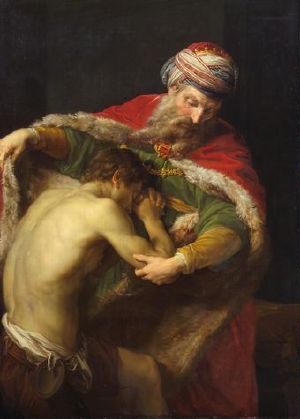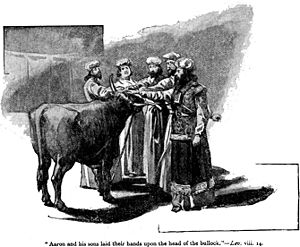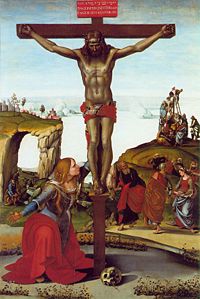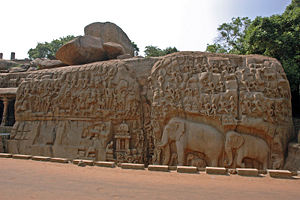Absolution

Absolution is the act of receiving forgiveness for one's sins or wrongdoings. Most religions have some concept of absolution, whether expressed ritually or not.
Ancient Jewish religion involved rites of priestly sacrifice by which a person who had sinned could receive absolution. Early Christianity abandoned this practice in favor of a believe that Christ had performed the ultimate sacrifice to absolve all believers of their sins through the acts of repentance and baptism. Later church tradition developed a formal liturgy by which, even after baptism, sinners could receive absolution from a priest. The Protestant Reformation downplayed the role of the priest in the process of absolution and evolved various traditions of the ministers role in the process, if any.
While contemporary Judaism has abandoned formal rituals of absolution, Jews still have the duty to seek absolution from those against whom they have sinned, both humans and God. Absolution is also an important part of Muslim worship, known asIstighfar. Buddhism also involves a tradition of confession and absolution, especially for monks and nuns. In Hinduism an act or rite of seeking absolution is known as Prayaschitta.
Ancient Jewish tradition

In the Hebrew Bible, God's forgiveness of sin was a major concern in the tradition of the Temple of Jerusalem and its priesthood. By bringing various offerings to the Temple, individuals, leaders, and the whole congregation of the Israelites could receive God's forgiveness. Traditionally, the practice of sin offerings and resulting absolution dates back to the time of the Exodus. The Book of Leviticus, for example, stipulates that "If a member of the community sins unintentionally... he must bring... a female goat without defect... The priest will make atonement for him, and he will be forgiven." (Leviticus 4:27-31). Female lambs were also acceptable as sin offerings, and if the person could not afford this, birds or flour could be substituted as well. An unintentional sin committed by a leader of the congregation required the sacrifice of a male goat rather than a female (4:22). If the whole Israelite community sinned, the assembly was to bring young bull as a sin offering.
Various other regulations governed the absolution of sin and ritual impurity, such as the payment of the "sanctuary shekel" (Lev. 5:16), for: "He must make restitution for what he has failed to do in regard to the holy things." Monetary restitution was also involved in cases of theft, in which case: "He must make restitution in full, add a fifth of the value to it and give it all to the owner," and also make a guilt offering.
Some sins, however, could not be forgiven, and must be punished with death. These included murder, adultery, homosexual sodomy, blasphemy, idolatry, cursing one's parent, and sabbath-breaking. It is not clear how strictly these rules were enforced, however.
Earliest Christianity

The first Christians were Jews and followed the Jewish law. However, especially through the teaching of Paul of Tarsus, the death of Jesus soon came to be seen as an atoning sacrifice made "once for all." Absolution was thus no long a matter of offering sacrifices through the Temple priests, but having faith in Jesus and being baptized.
For Paul, "our old self was crucified with him... that we should no longer be slaves to sin." (Rom. 6:6-7) The anonymous Epistle to the Hebrews portrayed Christ as the true "high priest" whose sacrifice of his own body was the sin offering for all those who believe in him. Thus, once one believed and had been baptized, offerings made at the Temple were obsolete.
After the Temple of Jerusalem itself was destroyed in 70 C.E., Jewish Christianity quickly declined and Pauline Christianity quickly predominated. Christians who were baptized were thus believed to have been forgiven of all previous sins. Ater baptism, one was a "new creature in Christ" and was supposed to live a holy life as a "saint," which at the time simply referred to any member of the Christian church as the "body of Christ." However, the question remained as to how sins committed after baptism could be absolved. Paul counseled that certain sins, especially the teaching of false doctrines and serious sexual sins, should not be forgiven by the church, but that those who committed them should be expelled or even turned in to the authorities for their crimes.
"A man has his father's wife... hand this man over to Satan, so that the sinful nature may be destroyed and his spirit saved on the day of the Lord... You must not associate with anyone who calls himself a brother but is sexually immoral or greedy, an idolater or a slanderer, a drunkard or a swindler. With such a man do not even eat." (1 Corinthians 5:1-5)
An especially difficult issue was what the Hebrew Bible had called "sins unto death," or mortal sins, which could not be forgiven by normal means of atonement. Many early Christians hoped for the rapid return of Jesus, but as this was prolonged, many found themselves in a state of mortal sin without a clear means to be absolved.
Evolving traditions of absolution
In the second century, the Montanist movement stress a puritanical lifestyle and adopted a strict standard, in which certain sins like murder, adultery, and apostasy could not be forgiven. Church Fathers like Tertullian were among the adherents of this policy. The popular apocalyptic writing known as the Shepherd of Hermas promised one final absolution of post-baptismal mortal sins before the imminent Second Coming of Christ. Some converts, knowing that they could not avoid committing sins, even postponed baptism under they were on the death-bed.
In the third and fourth centuries the issue of apostates returning to the church was especially contentious. The Novatianists held that those who denied the faith and committed idolatry could not be granted absolution by the church, for only God could forgive a mortal sin. The "catholic" (meaning universal) position, on the other hand, held that the church must be a home to sinners as well as saints, and that the bishops, as successors to Peter and the apostles, were authorized by God to forgive any sin.
It became the practice of penitent apostates to go to the confessors—those who had suffered for the faith and survived—to plead their case and effect their restoration to communion with the bishop's approval. The Catholic Church thus began to develop the tradition of confession, penance, and absolution, in order to provide a means for Christians to be forgiven of sins committed after baptism, including even mortal sins.
Catholicism

Absolution became an integral part of both the Catholic and Orthodox sacrament of penance and reconciliation. In the Catholic tradition, the penitent makes a formal confession of all mortal sins to a priest and prays an act of contrition. The priest then assigns a penance and offers absolution in the name of the Trinity, on behalf of the Church:
"God, the Father of mercies, through the death and resurrection of his Son has reconciled the world to himself and sent the Holy Spirit among us for the forgiveness of sins; through the ministry of the Church may God give you pardon and peace, and I absolve you from your sins in the name of the Father, and of the Son, and of the Holy Spirit. Amen."
This prayer of absolution by the priest, as God's minister, is believed to forgive the guilt associated with the penitent's sins and to remove the eternal punishment (in Hell) associated with mortal sins. The penitent is still responsible for the temporal punishment (in Purgatory) associated with the confessed sins, unless an indulgence is applied. If the sin is also a crime under secular law, the Church's forgiveness does not absolve the person of the need to pay his debt to society for the crime through fines, imprisonment, or other punishment.
Another form of absolution in Catholic tradition is general absolution, in which all eligible Catholics gathered at a given area are granted absolution for sins without prior individual confession to a priest. General absolution is authorized in only two circumstances:
- Imminent danger of death and there is no time for a priest or priests to hear the confessions of the individual penitents. A recent example was the general absolution granted to all Catholics endangered by the Three Mile Island nuclear accident.
- Other extraordinary needs: for example if the number of penitents is so large that there are not enough priests to hear the individual confessions properly within a reasonable time (generally considered to be one month). The diocesan bishop must give prior permission before general absolution is dispensed under this circumstance.
For a valid reception of general absolution, the penitent must be contrite for all his mortal sins and have the resolution to confess at the next earliest opportunity each of those mortal sins that is forgiven in general absolution. Anyone receiving general absolution is also required to make a complete individual confession to a priest as soon as possible before receiving general absolution again.
Othodoxy
The Orthodox practice of absolution is equally ancient to that of the Catholic, although the practice of confession is less formal and more be administered by a layperson as well as a priest. Absolution has been reaffirmed by Synod of Constantinople in 1638, the Synod of Jassy in 1642 and the Synod of Jerusalem, 1672, etc. The Synod of Jerusalem the specified the Orthodox belief in seven sacraments, among them penance—involving both confession and absolution—which the Christ established when he said: "Whose sins you shall forgive they are forgiven them, and whose sins you shall retain they are retained." (John 20:23)
After one confesses, the parish priest—who may or may not have heard the confession—covers the head of the person with his stole and reads the prayer of absolution, asking God to forgive the transgression of the individual. The Russian Orthodox version of absolution, in contrast to the Catholic, stresses the unworthiness of the minister and even his powerlessness to forgive sin, which God alone can do. One version of this prayer of absolution is as follows:
"My spiritual child, thou who hast confessed to my unworthy self, I, a humble sinner, have not the power to forgive sins on earth but God alone can do this... Whatsoever thou hast confessed to my deepest unworthiness and whatsoever thou hast omitted to say either through ignorance or forgetfulness, whatever it may be, God forgive thee in the present world and in that which is to come."
Variations in different Orthodox traditions, however, are considerable.
Protestantism
The Protestant Reformation brought an emphasis on the "priesthood of all believers" and a consequent dimunition in the role of priests as agents of absolution. However various attitudes and specific traditions of absolution soon emerged.
In Lutheranism, personal repentance and faith in Jesus' atoning sacrifice are considered sufficient conditions for absolution. However, although the Lutherans completely eliminated the practice of acts of contrition as evidence of "works righteousness," they retained the rites of confession and absolution with a priest. More recently, these formal rites are practiced only when requested by the penitent or recommended by the confessor or pastor.
The Swiss reformer Huldrych Zwingli, on the other hand, saw nothing but idolatry in the practice involving a human agent in absolution, holding that God alone pardoned sin. John Calvin denied that penance was an authentic sacrament, but he held that the pardon expressed by the minister of the church has helpful to the penitent's sense of forgiveness.
In the Anglican Communion, whose break from Rome was less about sacraments than about church politics, absolution usually takes place after the General Confession during the Eucharist or a daily office, and is a component of the sacrament of confession and absolution. It may also pronounced after the reconciliation of a penitent by the priest hearing a private confession.
Protestant traditions of the Radical Reformation (such as Baptists, Anabaptists, and Mennonites—as well as some in the Restoration Movement—stress absolution as taking place primarily at the time of baptism. Many Protestants reject the idea that the minister has any role at all in absolution, except insofar as his preaching and praying may held the individual believe develop a greater sense of having received God's forgiveness.
Other religions
Most religions have some kind of concept of absolution even if they do not have formal rituals related to it. Judaism, which once involved highly formalized traditions of absolution through ritual sacrifice has evolved in the rabbinic into a religion stressing atonement through prayer. For sins against any human, one must go to those he has harmed in order to receive absolution from them. According the compilation of Jewish law known as the Shulchan Aruch (OC 606:1) a person who sincerely apologizes three times for a wrong committed against another has fulfilled his or her obligation to seek forgiveness. Unlike in Christianity, a person cannot obtain forgiveness from God for wrongs the person has done to other people. In association with the holiday of Yom Kippur, Jews are supposed to ask forgiveness from any persons from whom they have not yet received absolution. They also fast and pray for God's forgiveness for the sins they have made against God, but God can only forgive only the sins a person has committed against God.

In Islam, absolution is one of essential parts of worship. However, just as in Judaism, it does not involve the action of a priest. The act of seeking absolution is called Istighfar. It is generally done by repeating the Arabic phrase astaghfirullah, meaning "I seek forgiveness from Allah," while praying. Many Muslims use this phrase often, even in casual conversation. After every formal prayer, a Muslim will typically recite the phrase three or more times. Even if a Muslim only sins internally, such as by eperiencing feelings of envy, jealousy, arrogance, or lust, they are supposed to ask absolution from Allah in this fashion.
In Buddhist tradition, the disciples of the Buddha are portrayed as sometimes confessing their wrongdoings to Buddha and received absolution of a sort from him. Confessing one's faults to a superior and receiving penance and absolution is an important part of the spiritual practice of many Buddhist monks.
The concept of asking for forgiveness and receiving absolution is also a part of the practice of Hinduism, related to the Sanskrit concept of Prayaschitta. The term denotes an act or rite intended for the destruction of sin. Derived from the law of Karma, Prayashitta must be performed not only to restore one's sense of harmony with the Divine, but also to avoid the future consequences of sin, either in this life or the next.
Notes
External Links
- Christian Cyclopedia Article on Absolution Retrieved September 16, 2007.
- Luther, Martin. Smalcald Articles VIII. Of Confession Retrieved September 16, 2007.
- Melanchthon, Philip. The Augsburg Confession Article XI: Of Confession. Retrieved September 16, 2007.
- Melanchthon, Philip. The Defense of the Augsburg Confession Article VI: Of Confession and Satisfaction Retrieved September 16, 2007.
Credits
New World Encyclopedia writers and editors rewrote and completed the Wikipedia article in accordance with New World Encyclopedia standards. This article abides by terms of the Creative Commons CC-by-sa 3.0 License (CC-by-sa), which may be used and disseminated with proper attribution. Credit is due under the terms of this license that can reference both the New World Encyclopedia contributors and the selfless volunteer contributors of the Wikimedia Foundation. To cite this article click here for a list of acceptable citing formats.The history of earlier contributions by wikipedians is accessible to researchers here:
The history of this article since it was imported to New World Encyclopedia:
Note: Some restrictions may apply to use of individual images which are separately licensed.

